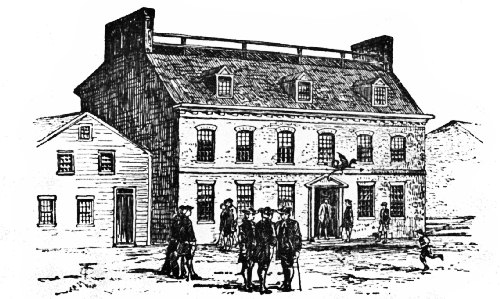|
Well, you know recently my Jude had a birthday and I wanted to get her something that would be special...I thought on that a while and decided that she always enjoyed doing genealogy work. Sooo, I got her the newest edition of Family Tree Maker software. When we opened up the box, we discovered that it had a "gift"...sooo, I asked her to gift it to me! That is how this piece got into the newsletter...what you say, that does not make sense?? Well you see I started looking up my ancestry online using this software and BOY has it improved!!! I kept seeing documentation for applications for Sons of the American Revolution...that got my attention, don't you know! So, my next thought was whether or not coffee had anything to do with this uprising that brought our freedom...and here is an interesting tidbit found in "All About Coffee," by William H. Ukers that I thought you might enjoy.
INTRODUCTION OF COFFEE INTO NORTH AMERICA
New England's Most Famous Coffee House
The Green Dragon, the last of the inns that were popular at the close of the seventeenth century, was the most celebrated of Boston's coffee-house taverns. It stood on Union Street, in the heart of the town's business center, for 135 years, from 1697 to 1832, and figured in practically all the important local and national events during its long career. Red-coated British soldiers, colonial governors, bewigged crown officers, earls and dukes, citizens of high estate, plotting revolutionists of lesser degree, conspirators in the Boston Tea Party, patriots and generals of the Revolution-all these were wont to gather at the Green Dragon to discuss their various interests over their cups of coffee, and stronger drinks. In the words of Daniel Webster, this famous coffee-house tavern was the "headquarters of the Revolution." It was here that Warren, John Adams, James Otis, and Paul Revere met as a "ways and means committee" to secure freedom for the American colonies. Here, too, came members of the Grand Lodge of Masons to hold their meetings under the guidance of Warren, who was the first grand master of the first Masonic lodge in Boston. The site of the old tavern, now occupied by a business block, is still the property of the St. Andrew's Lodge of Free Masons. The old tavern was a two-storied brick structure with a sharply pitched roof. Over its entrance hung a sign bearing the figure of a green dragon.

The Green Dragon, the Center of Social and Political Life in Boston for 135 Years
This tavern figured in practically all the important national affairs from 1697 to 1832, and, according to Daniel Webster, was the "headquarters of the Revolution"
Patrons of the Green Dragon and the British coffee house were decidedly opposed in their views on the questions of the day. While the Green Dragon was the gathering place of the patriotic colonials, the British was the rendezvous of the loyalists, and frequent were the encounters between the patrons of these two celebrated taverns. It was in the British coffee house that James Otis was so badly pummeled, after being lured there by political enemies, that he never regained his former brilliancy as an orator.
It was there, in 1750, that some British red coats staged the first theatrical entertainment given in Boston, playing Otway's Orphan. There, the first organization of citizens to take the name of a club formed the Merchants' Club in 1751. The membership included officers of the king, colonial governors and lesser officials, military and naval leaders, and members of the bar, with a sprinkling of high-ranking citizens who were staunch friends of the crown. However, the British became so generally disliked that as soon as the king's troops evacuated Boston in the Revolution, the name of the coffee house was changed to the American.
The Bunch of Grapes, that Francis Holmes presided over as early as 1712, was another hot-bed of politicians. Like the Green Dragon over the way, its patrons included unconditional freedom seekers, many coming from the British coffee house when things became too hot for them in that Tory atmosphere. The Bunch of Grapes became the center of a stirring celebration in 1776, when a delegate from Philadelphia read the Declaration of Independence from the balcony of the inn to the crowd assembled in the street below. So enthusiastic did the Bostonians become that, in the excitement that followed, the inn was nearly destroyed when one enthusiast built a bonfire too close to its walls. Another anecdote told of the Bunch of Grapes concerns Sir William Phipps, governor of Massachusetts from 1692-94, who was noted for his irascibility. He had his favorite chair and window in the inn, and in the accounts of the period it is written that on any fine afternoon his glowering countenance could be seen at the window by the passers-by on State Street.
|